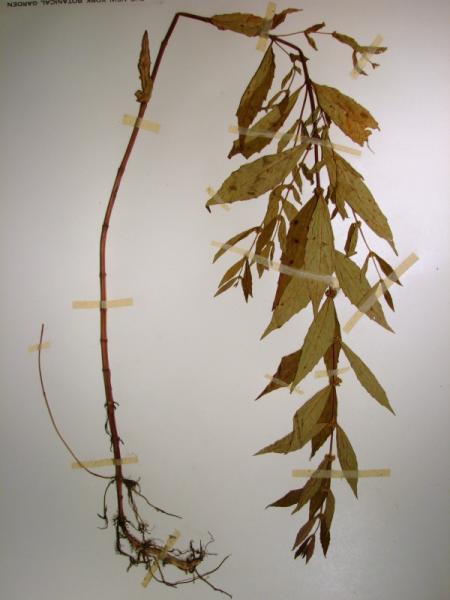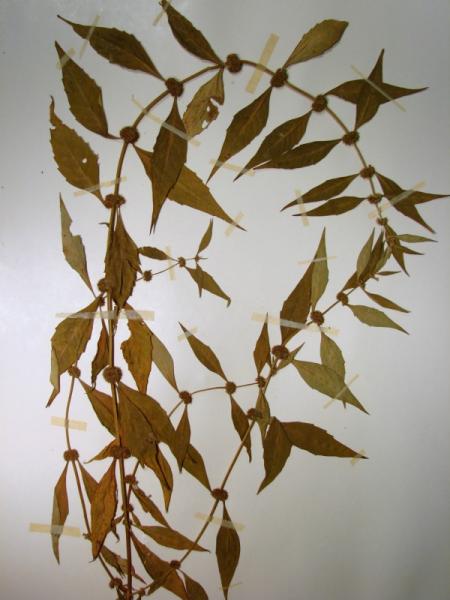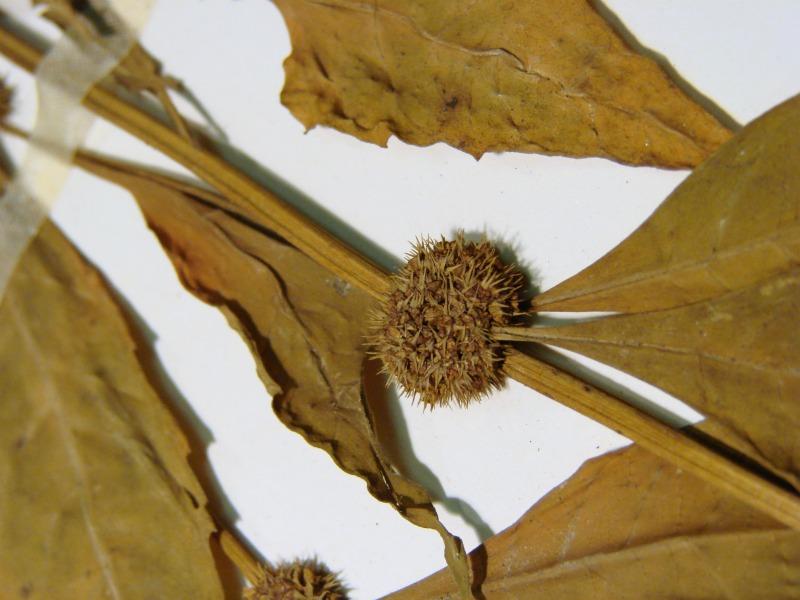Stalked Bugleweed
Lycopus rubellus Moench
- Class
- Dicotyledoneae (Dicots)
- Family
- Lamiaceae (Mint Family)
- State Protection
- Endangered
Listed as Endangered by New York State: in imminent danger of extirpation in New York. For animals, taking, importation, transportation, or possession is prohibited, except under license or permit. For plants, removal or damage without the consent of the landowner is prohibited.
- Federal Protection
- Not Listed
- State Conservation Status Rank
- S1
Critically Imperiled in New York - Especially vulnerable to disappearing from New York due to extreme rarity or other factors; typically 5 or fewer populations or locations in New York, very few individuals, very restricted range, very few remaining acres (or miles of stream), and/or very steep declines.
- Global Conservation Status Rank
- G5
Secure globally - Common in the world; widespread and abundant (but may be rare in some parts of its range).
Summary
Did you know?
Stalked bugleweed is also known as stalked water horehound. Horehound comes from the Old English words har and hune, meaning downy plant. This descriptive name refers to the white hairs that give the related European herb Marrubium vulgare its distinctive hoary appearance. Another suggested derivation is from the name of the Egyptian god of sky and light, Horus. (Horehound in: Encyclopedia of alternative medicine by Claire Hanrahan at FindArticles.com. 15 Nov. 2007).
State Ranking Justification
There are five existing populations but all of them are small and their continued existence may be tenuous. There are 10 historical occurrences but none of them have been relocated.
Short-term Trends
More survey work is needed to understand short-term trends as most populations have not been resurveyed in detail.
Long-term Trends
This species has always existed in low numbers in the state. There are probably never more than five existing populations at one time.
Conservation and Management
Threats
One population was found on the side of a boat dock that may be affected by the future decay of the dock. Information about threats has not been gathered for other populations.
Conservation Strategies and Management Practices
Not enough is known about the current conditions of these populations to recommend specific management techniques other than the protection of the wetlands where they occur.
Research Needs
Herbarium studies are needed to determine if specimens of this species were originally identified as closely related common species.
Habitat
Habitat
In New York Lycopus rubellus has been found in marshes, fens, and flooded swamps, and at one site, growing from cracks in the stone wall of a dock along the Hudson River. More habitat information is needed from the few stations of this species in the state (New York Natural Heritage Program 2007). Damp soils of woods, thickets, etc. (Fernald 1970).
Associated Ecological Communities
- Marine riprap/artificial shore
The wetland community of a constructed marine shore in which the substrate is composed of broken rocks, stones, wooden bulkheads, or concrete placed to reduce erosion.
- Medium fen
(guide)
A wetland fed by water from springs and seeps. These waters are slightly acidic (pH values generally range from 4.5 to 6.5) and contain some dissolved minerals. Plant remains in these fens do not decompose rapidly and thus the plants in these fens usually grow on older, undecomposed plant parts of woody material, grasses, and mosses.
- Shallow emergent marsh*
(guide)
A marsh meadow community that occurs on soils that are permanently saturated and seasonally flooded. This marsh is better drained than a deep emergent marsh; water depths may range from 6 in to 3.3 ft (15 cm to 1 m) during flood stages, but the water level usually drops by mid to late summer and the soil is exposed during an average year.
* probable association but not confirmed.
Associated Species
- Osmunda regalis
- Pilea fontana (black-fruited clearweed)
- Scirpus cyperinus (common wool-grass)
- Sphagnum
Range
New York State Distribution
All the known, extant sites for this species are in the Lower Hudson Valley and Long Island. There are also historical records from Erie and Niagara Counties in western New York and Franklin County in the north.
Global Distribution
Lycopus rubellus is found throughout most of the Eastern U.S., ranging from New York and Massachusetts to Florida in the east, and to Texas and Kansas in the west, reaching the northwestern edge of its range in Ontario and Michigan.
Identification Comments
General Description
Lycopus rubellus is a perennial herb, growing erect from tuberous stolons (underground stems). It has opposite, toothed, petiolate leaves 5-10 cm long. The flowers are white, tiny (3.5 to 4mm long), and grouped into ball-like infloresences where the leaves meet the stem. The sepals are green, half as long as the petals, and longer than the fruit, which are tiny (1-1.6mm) nutlets.
Best Life Stage for Proper Identification
Stems with fruit or flowers are needed for identification.
Similar Species
Lycopus virginicus and L. uniflorus have smaller calyx lobes that are shorter than the fruit; L. europaeus, an introduced species, has stiff, appressed hairs on the underside of the leaves (L.rubellus' leaves are glabrous or only nearly so); L. asper, L. anguistifolius, and L. amplectens all have sessile leaves (Gleason and Cronquist 1991, Voss 1996, Rhoads and Klein 2000).
Best Time to See
Lycopus rubellus flowers from July to mid-August, and the fruits mature August through September and persist to early October.
- Flowering
- Fruiting
The time of year you would expect to find Stalked Bugleweed flowering and fruiting in New York.
Stalked Bugleweed Images
Taxonomy
Stalked Bugleweed
Lycopus rubellus Moench
- Kingdom Plantae
- Phylum Anthophyta
- Class Dicotyledoneae
(Dicots)
- Order Lamiales
- Family Lamiaceae (Mint Family)
- Order Lamiales
- Class Dicotyledoneae
(Dicots)
- Phylum Anthophyta
Additional Common Names
- Bugleweed
- Stalked Water Horehound
Additional Resources
Best Identification Reference
Gleason, Henry A. and A. Cronquist. 1991. Manual of Vascular Plants of Northeastern United States and Adjacent Canada. The New York Botanical Garden, Bronx, New York. 910 pp.
Other References
Clemants, Steven and Carol Gracie. 2006. Wildflowers in the Field and Forest. A Field Guide to the Northeastern United States. Oxford University Press, New York, NY. 445 pp.
Crow, Garrett E. and C. Barre Hellquist. 2000. Aquatic and Wetland Plants of Northeastern North America: A revised and enlarged edition of Norman C. Fassett's a Manual of Aquatic Plants. Volume One: Pteridophytes, Gymnosperms, and Angiosperms: Dicotyledons. The University of Wisconsin Press. Madison, Wisconsin. 536 Pages.
Fernald, M.L. 1950. Gray's manual of botany. 8th edition. D. Van Nostrand, New York. 1632 pp.
Herman, Frederick J. 1936. Diagnostic Characters in Lycopus. Rhodora 38(455): 373-375. November 1936.
Holmgren, Noel. 1998. The Illustrated Companion to Gleason and Cronquist's Manual. Illustrations of the Vascular Plants of Northeastern United States and Adjacent Canada. The New York Botanical Garden, Bronx, New York.
New York Natural Heritage Program. 2010. Biotics database. New York Natural Heritage Program. New York State Department of Environmental Conservation. Albany, NY.
New York Natural Heritage Program. 2024. New York Natural Heritage Program Databases. Albany, NY.
Rhoads, Ann F. and Timothy A. Block. 2000. The Plants of Pennsylvania, an Illustrated Manual. University of Pennsylvania Press, Philadelphia, PA.
Voss, Edward G. 1996. Michigan Flora Part III. Dicots Concluded (Pyrolaceae - Compositae). Cranbrook Institute of Science Bulletin 61 and University of Michigan Herbarium. 622 pp.
Weldy, T. and D. Werier. 2010. New York flora atlas. [S.M. Landry, K.N. Campbell, and L.D. Mabe (original application development), Florida Center for Community Design and Research http://www.fccdr.usf.edu/. University of South Florida http://www.usf.edu/]. New York Flora Association http://newyork.plantatlas.usf.edu/, Albany, New York
Weldy, Troy W. and David Werier. 2005. New York Flora Atlas. [S.M. Landry, K.N. Campbell, and L.D. Mabe (original application development), Florida Center for Community Design and Research. University of South Florida]. New York Flora Association, Albany, NY. Available on the web at (http://newyork.plantatlas.usf.edu/).
Links
About This Guide
Information for this guide was last updated on: October 5, 2022
Please cite this page as:
New York Natural Heritage Program. 2024.
Online Conservation Guide for
Lycopus rubellus.
Available from: https://guides.nynhp.org/stalked-bugleweed/.
Accessed July 26, 2024.



